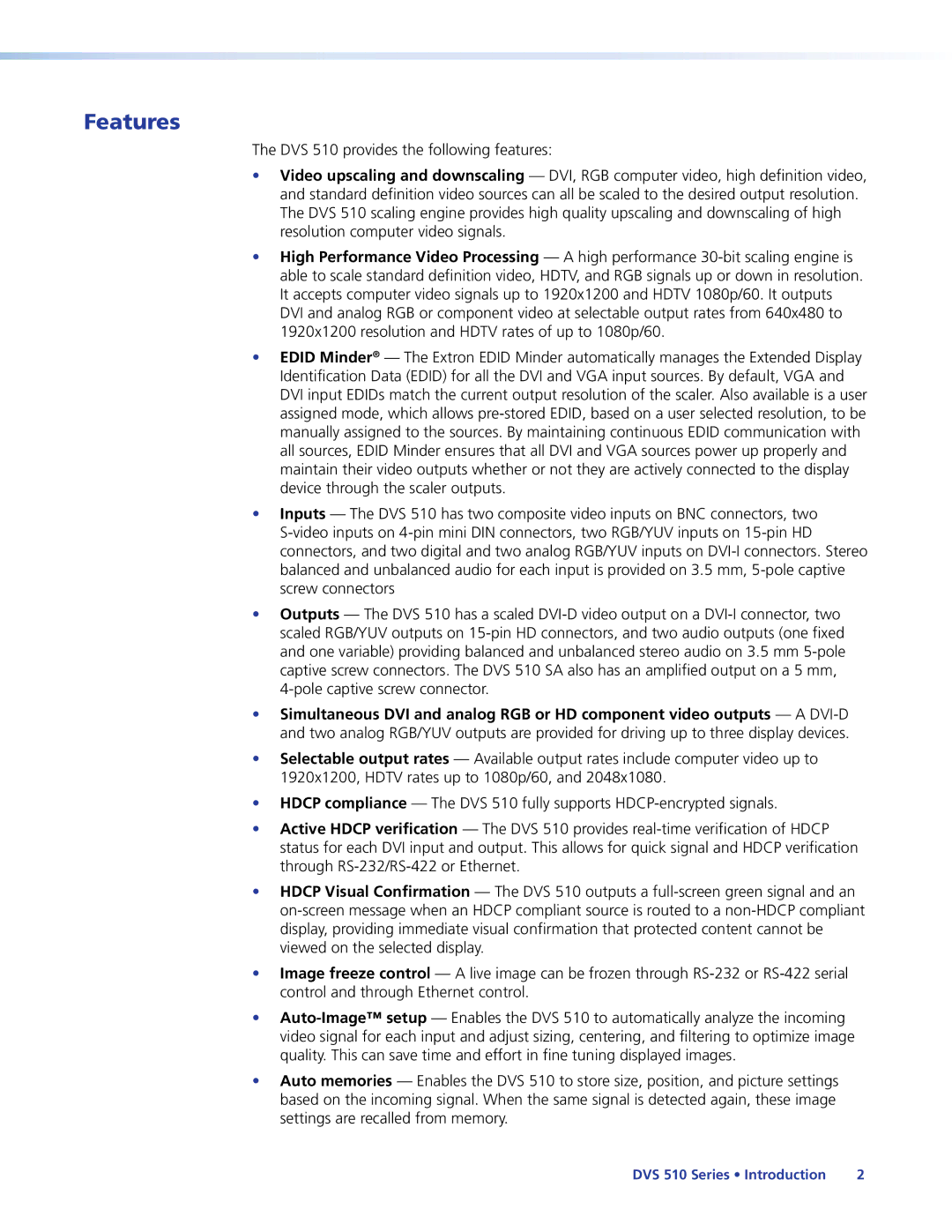Features
The DVS 510 provides the following features:
•Video upscaling and downscaling — DVI, RGB computer video, high definition video, and standard definition video sources can all be scaled to the desired output resolution.
The DVS 510 scaling engine provides high quality upscaling and downscaling of high resolution computer video signals.
•High Performance Video Processing — A high performance 30-bit scaling engine is able to scale standard definition video, HDTV, and RGB signals up or down in resolution. It accepts computer video signals up to 1920x1200 and HDTV 1080p/60. It outputs DVI and analog RGB or component video at selectable output rates from 640x480 to 1920x1200 resolution and HDTV rates of up to 1080p/60.
•EDID Minder® — The Extron EDID Minder automatically manages the Extended Display Identification Data (EDID) for all the DVI and VGA input sources. By default, VGA and DVI input EDIDs match the current output resolution of the scaler. Also available is a user assigned mode, which allows pre-stored EDID, based on a user selected resolution, to be manually assigned to the sources. By maintaining continuous EDID communication with all sources, EDID Minder ensures that all DVI and VGA sources power up properly and maintain their video outputs whether or not they are actively connected to the display device through the scaler outputs.
•Inputs — The DVS 510 has two composite video inputs on BNC connectors, two S-video inputs on 4-pin mini DIN connectors, two RGB/YUV inputs on 15-pin HD connectors, and two digital and two analog RGB/YUV inputs on DVI-I connectors. Stereo balanced and unbalanced audio for each input is provided on 3.5 mm, 5-pole captive screw connectors
•Outputs — The DVS 510 has a scaled DVI-D video output on a DVI-I connector, two scaled RGB/YUV outputs on 15-pin HD connectors, and two audio outputs (one fixed and one variable) providing balanced and unbalanced stereo audio on 3.5 mm 5-pole captive screw connectors. The DVS 510 SA also has an amplified output on a 5 mm,
4-pole captive screw connector.
•Simultaneous DVI and analog RGB or HD component video outputs — A DVI-D and two analog RGB/YUV outputs are provided for driving up to three display devices.
•Selectable output rates — Available output rates include computer video up to
1920x1200, HDTV rates up to 1080p/60, and 2048x1080.
•HDCP compliance — The DVS 510 fully supports HDCP-encrypted signals.
•Active HDCP verification — The DVS 510 provides real-time verification of HDCP status for each DVI input and output. This allows for quick signal and HDCP verification through RS-232/RS-422 or Ethernet.
•HDCP Visual Confirmation — The DVS 510 outputs a full-screen green signal and an on-screen message when an HDCP compliant source is routed to a non-HDCP compliant display, providing immediate visual confirmation that protected content cannot be viewed on the selected display.
•Image freeze control — A live image can be frozen through RS-232 or RS-422 serial control and through Ethernet control.
•Auto-Image™ setup — Enables the DVS 510 to automatically analyze the incoming video signal for each input and adjust sizing, centering, and filtering to optimize image quality. This can save time and effort in fine tuning displayed images.
•Auto memories — Enables the DVS 510 to store size, position, and picture settings based on the incoming signal. When the same signal is detected again, these image settings are recalled from memory.
